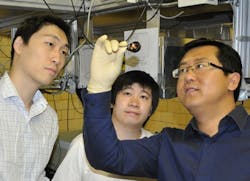Iowa State physics researchers find broadband optical gain in graphene
Ames, IA--A group of scientists at Iowa State University, led by physicist Jigang Wang, has shown that graphene has two very important optical properties: population inversion of electrons, and broadband optical gain.1 As a result, graphene has potential for use in lasers and amplifiers. Other members in the group are from Ames Laboratory.
Wang's team irradiated graphene monolayers with 35 fs laser pulses, finding a new photo-excited graphene state characterized by a broadband population inversion of electrons—revealing itself as negative conductivity in the near-IR for the first 200 fs, in which stimulated emission completely compensates absorption loss.
"It's very exciting," Wang says. "It opens the possibility of using graphene as a gain medium for light amplification. It could be used in making broadband optical amplifiers or high-speed modulators for telecommunications. It even provides implications for development of graphene-based lasers."
An understanding gap existed, Wang explains, between the two scientific communities that studied the electronic and photonic properties of graphene. He believed his group could help bridge the gap by elaborating the nonlinear optical properties of graphene and understanding the nonequilibrium electronic state. He says that other scientists have studied graphene's optical properties, but primarily in the linear regime. His team hypothesized they could generate a new very unconventional state of graphene resulting in population inversion and optical gain.
"We were the first group to break new ground, to start looking at it in a highly excited state consisting of extremely dense electrons—a highly nonlinear state," says Wang. "In such a state, graphene has unique properties."
Negative absorption shows optical gain
Wang's group started with high-quality graphene monolayers grown in the Ames Laboratory. The researchers used an ultrafast laser to excite the material's electrons with 35 fs pulses. Through measurements of the photoinduced electronic states, Wang's team found that optical conductivity (or absorption) of the graphene layers changed from positive to negative when the pump pulse energy was increased above a threshold.
"The light emitted shows gain of about 1% for a layer a mere one atom thick, a figure on the same order to what's seen in conventional semiconductor optical amplifiers hundreds of times thicker," says Wang.
The key to the experiments, of course, was creating the highly nonlinear state, something "that does not normally exist in thermal equilibrium," Wang says. "You cannot simply put graphene under the light and study it. You have to really excite the electrons with the ultrafast laser pulse and have the knowledge on the threshold behaviors to arrive at such a state."
Wang said a great deal more engineering and materials perfection lies ahead before graphene's full potential for lasers and optical telecommunications is ever realized.
REFERENCE:
T. Li et al., Phys. Rev. Lett. 108, 167401 (2012).
About the Author
John Wallace
Senior Technical Editor (1998-2022)
John Wallace was with Laser Focus World for nearly 25 years, retiring in late June 2022. He obtained a bachelor's degree in mechanical engineering and physics at Rutgers University and a master's in optical engineering at the University of Rochester. Before becoming an editor, John worked as an engineer at RCA, Exxon, Eastman Kodak, and GCA Corporation.

